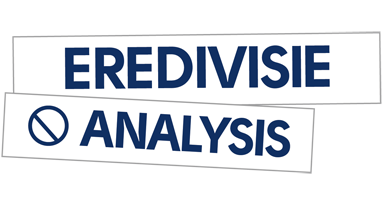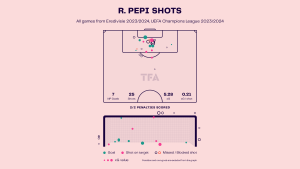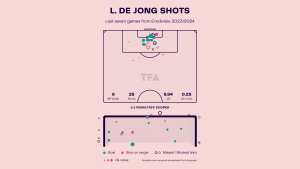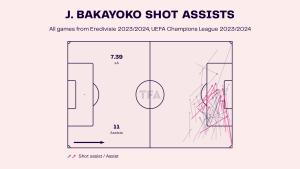The Estadio Alfredo Di Stéfano played host to Spain against Ukraine in the second round of UEFA Nations League fixtures. A recent influx of new young players had previously helped Spain secure a draw away in Germany. Ukraine had managed an efficient performance against Switzerland, coming away with a 2-1 win.
Spain came out victorious with an emphatic 4-0 win. Their ability to quickly switch the play and create overloads in wide areas meant that Ukraine seriously struggled to defend against the likes of Ansu Fati. A combination of potency in the Spanish attack and lack of response tactically from Andriy Shevchenko meant that it was all too easy for Spain to secure the three points. This tactical analysis will explore both sides in more detail.
Lineups
Luis Enrique’s side set up in a 4-3-3 formation, a change from the 4-1-4-1 shape that they’d previously played during their draw to Germany. Spain’s tactics were a statement of Spain’s intent to implement an attacking game plan, with winger Jesus Navas redeployed as a right-wing back. Both Navas and Reguilón played much higher up the pitch in the second line when in possession. Rodri sat in the middle of the midfield and dropped back to form a three with Ramos and Torres when Spain attacked. This left Thiago and Merino room to advance and look to play passes through the Ukraine defence, or more commonly to switch the play to the opposite winger.
Ukraine set up in a similar shape. Shevchenko replaced Yevhen Konoplyanka with Roman Yaremchuk on the left and played Marlos, who is more commonly deployed as a winger, through the middle. Inexperienced full-backs Oleksandr Tymchyk and Bogdan Mykhaylichenko initially aimed to move into more advanced positions in order to be able to have a similar impact to their last game in which they picked up an assist each. Oleksandr Zinchenko and Ruslan Malinovskyi looked to take up similar roles to their opposite numbers as well as trying to win interceptions, while debutant Ihor Khatarin replaced Taras Stepanenko’s deeper-lying role in midfield.
Spain in attack
Spain’s attacking plan was clear from the start and was implemented without any significant resistance from Ukraine.
During the first phase of attack, wing-backs Navas and Reguilón advanced up the pitch. Rodri dropped in front of the two centre backs and the central midfielders (usually Thiago) or Sergio Ramos looking to spray balls out wide. The target of these diagonal balls tended to be Ansu Fati more often than right-winger Dani Olmo. This can likely be attributed to Olmo being a right-footed right-winger, resulting in a hesitancy to cut inside, as well as Fati simply proving he was far superior in 1v1 situations on the night.
The winger receiving the ball in this situation was a trigger for the full-backs to attempt to overlap, taking the Ukrainian full-back out of the game. This led to a rush to enter the 18-yard box in order to get onto the end of the full back’s crosses. Fati or Olmo (dependent on the side of the pitch) held their runs back in order to ensure there was an option to cut back.
Bypassing the Ukrainian press
Ukraine did initially attempt a press with their front three, though it did lack the intensity required to have any significant effect and was easily bypassed by the Spanish defence. Spain would counter this by playing inside and back out to the wing, with one of the centre backs looking to play to one of the members of the triangle in midfield and then back out to a full back who by this point is too far advanced for the pressing winger to recover.
The added advantage of this method of breaking lines is that with the winger taken out of the game, it sets up a 2v1 overload against the full-back with both the attacking full-back and winger able to work against them. Spain did, however, struggle to effectively exploit these overloads on both sides of the pitch. Fati and Reguilón bypassed Tymchyk with ease but Navas seemed hesitant to advance further towards Mykhaylichenko – despite the fact that there was both a numerical and qualitative advantage over the Anderlecht right back.
Ansu Fati
It would be unfair for any analysis of this game to fail to fully appreciate the contribution of Ansu Fati who largely ran the show in attack for Spain. WhoScored data indicates the 17-year-old attempted more shots (6) and dribbles (4) than any other player on the pitch. His contributions led to his first goal for La Roja as well as winning the penalty that Ramos went on to convert to put Spain 1-0 up.
The fact that 40% of Spain’s shots came from the left-hand side of the pitch compared to 8% of the from the right may be attributed to one of two factors (or more likely a combination of the two). The first is that due to the fact that Dani Olmo is a right-footed winger on the right-hand side, he is likely to be more uncomfortable cutting inside than Fati (who is a right-footed winger on the left). Secondly, Fati had a significant impact on the game right from the start and was clearly both confident and capable of being able to beat players and create chances.
The 17-year-old Barcelona winger is making a serious case for himself as a genuine contender for a starting spot at the EUROs next year. Providing he’s able to get further game time at Barcelona (which looks like a real possibility due to the fact they’re in a rebuilding phase) and keeps on producing performances at this level, it would be a surprise if Luis Enrique completely looked past him.
Both Spain’s threat from long diagonal balls and use of wing backs in attack continued in more advanced positions. Once they had comfortably gained control of the ball in the opposition half, wingers Fati and Olmo would look to drop in more centrally towards zone 14, crowding the central area in front of Ukraine’s 18-yard box. Thiago also pushed up into this area while Ramos replaced his position alongside Rodri and Merino in the second line to further crowd this zone. As a result of this crowding Ukraine reverted to a narrow back four with Tymchyk man-marking Fati, leaving wide space for Reguilón to invade in the 18-yard box where he would be free to get a shot or cross off.
Spain’s midfield press
While it was the attacking capability of 17-year-old Ansu Fati that captured the attention, Spain won the game in midfield with Thiago putting on a masterclass of midfield pressing.
The effectiveness of this pressing was reflected in the possession stats and ensured Ukraine were rarely allowed to progress through the middle third of the pitch. In addition to Spain’s 69.8% overall possession, WhoScored stats show that goalkeeper Andriy Pyatov had more touches of the ball than any other Ukraine player (53) which highlights the effectiveness of Spain’s pressing.
Ukraine looked to play from defence into midfielders Zinchenko, Malinovskyi or debutant Ihor Kharatin who dropped slightly deeper. Zinchenko and Malinovskyi advanced further up the pitch in order to utilise their attacking capabilities. Spain encouraged Ukraine to play into the pressing trap by cutting off passing lanes through the midfield, then pressing the full-backs aggressively through Fati or Olmo and forcing a pass to Kharatin (fig. 1). Thiago would then press the man on the ball (who would receive with his back to the Spaniard) extremely aggressively, ensuring the angle of the press didn’t allow for any passes sideways to the Yarmolenko for example (fig. 2). This forced a rushed pass back into the Ukrainian defence in the hope that Gerard Moreno could intercept or win the ball by further pressing the defenders (fig. 3).
Ukraine attempted to counter these pressing traps by getting Zinchenko to drop deeper and receive the ball between the lines. While Zinchenko is commonly deployed as a left-back in Pep Guardiola’s sides, it’s important to remember that he is a talented player when it comes to dribbling and 1v1 situations as he proved at both FC Ufa and PSV. Zinchenko was much more successful than Kharatin in terms of his progressions up the pitch but Ukraine once again struggled to enter or create any real chances in the final third.
Unfortunately for Ukraine, Thiago’s relentless pressing was enough to ensure this threat from Zinchenko was eliminated fairly swiftly, pressing even further up the pitch approaching the final third. Zinchenko keeps showing hints of attacking potential but Shevchenko will be hoping that he can find a way of maximising his effectiveness in this area before Ukraine begin their EURO 2021 campaign in June.
Ukraine
After their 2-1 win against Switzerland, many were expecting more from Ukraine than they managed to produce against the Spaniards. Similarly to the game against Spain, Ukraine had had less possession but managed to make the most of either counter attacks or shots from range. However, due to the fact that Ukraine struggled to control the ball at all in the opposition half, they managed only 1 shot from range and found themselves counter-attacking in a less controlled or decisive manner due to the fact that it was the only option they had left.
Vulnerabilities in defence
Ukraine set up in a way that suggested they were prepared to try and press the opposition, in a 4-3-3 shape with a fairly high defensive line, leaving little space between their defence and midfield lines. They aimed to win the ball in midfield through Zinchenko and Malinovskyi and then attack quickly with their front three.
They defended central areas effectively more often than not but struggled to reduce the impact of Spain’s attacks that were primarily being built on the wings by this point. Compactness in the middle is a good move when it comes to stopping passes through the lines to Moreno for example, but against a team whose 4 wide players can all contribute significantly in attack, it is far too dangerous to leave this much space in behind.
Sergio Ramos and Pau Torres’ passing abilities proved to be a vital tool in exploiting this weakness, managing 84 and 125 in total respectively. These long diagonal passes would either take the full-back out of the game and allow the winger to advance towards goal or set up another 2v1 (winger + wing back vs full back).
After finding themselves three goals down within the first half, they reverted to a lower block. This was an attempt to absorb Spain’s attacking threat and reduce the space in behind available for the wingers and overlapping full-backs to exploit.
Shevchenko’s side reverted to this plan B of sitting deep and putting their faith in the ability of their front three to counter. But ultimately this was the full extent of Ukraine’s attacking threat due to the sheer dominance of Spain in almost every area of the game. Shevchenko’s side did finish the game with more interceptions (11) than their opponents and so it made sense that they would try and make the most of this, albeit small, advantage.
Due to the fact that Ukraine set up for damage limitation fairly early on in the game, they struggled to make anything of the valuable counter-attacking chances that they were presented with. Yarmolenko seemed to be the only member of the front three who was confident enough to take on the Spanish defenders, with both Marlos and Yaremchuk either delayed or diverted comfortably by Ramos and Torres.
Conclusion
In purely tactical terms, Spain showed great strength in managing to effectively exploit weaknesses in the opposition and demonstrated that their midfield three can significantly contribute to both attack and defence. The effectiveness of both Thiago’s playmaking abilities and aggressiveness when pressing goes further towards confirming that he’d be an outstanding addition to Liverpool’s squad. These factors mean that Spain should expect to progress to the finals of the UEFA Nations League.
On paper, Ukraine has one of their most exciting squads in years with individuals such as Zinchenko and Yarmolenko capable of making an impact on the European stage, but Andriy Shevchenko must develop his teams’ ability to adapt tactically quickly and more effectively. While Spain did put in an excellent performance, Ukraine are capable of far more than they showed and should be able to compete once they manage to recognise and respond to weaknesses defensively, as well as ensuring all three forwards have active roles in counter-attacks.























